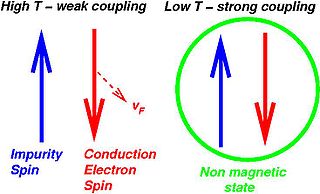Kondo effect
In physics, the Kondo effect describes the scattering of conduction electrons in a metal due to magnetic impurities, resulting in a characteristic change in electrical resistivity with temperature.[1]
The effect was first described by Jun Kondo, who applied third-order perturbation theory to the problem, which predicted that the scattering rate of conduction electrons of the magnetic impurity should diverge as the temperature approaches 0 K.[2] The temperature dependence of the resistivity including the Kondo effect is written as:

where ρ0 is the residual resistance, aT2 shows the contribution from the Fermi liquid properties, and the term bT5 is from the lattice vibrations; a, b and cm are constants. Jun Kondo derived the third term of the logarithmic dependence. Later calculations refined this result to produce a finite resistivity but retained the feature of a resistance minimum at a non-zero temperature. One defines the Kondo temperature as the energy scale limiting the validity of the Kondo results. The Anderson impurity model and accompanying renormalization theory were an important contribution to understanding the underlying physics of the problem.[3]

The Kondo effect can be considered as an example of asymptotic freedom, i.e. a situation where the coupling becomes non-perturbatively strong at low temperatures and low energies. In the Kondo problem, the coupling refers to the interaction between the localized magnetic impurities and the itinerant electrons.
Extended to a lattice of magnetic impurities, the Kondo effect likely explains the formation of heavy fermions and Kondo insulators in intermetallic compounds, especially those involving rare earth elements like cerium, praseodymium, and ytterbium, and actinide elements like uranium. In heavy fermion materials, the nonperturbative growth of the interaction leads to quasi-electrons with masses up to thousands of times the free electron mass, i.e., the electrons are dramatically slowed by the interactions. In a number of instances they actually are superconductors. More recently, it is believed that a manifestation of the Kondo effect is necessary for understanding the unusual metallic delta-phase of plutonium.
More recently the Kondo effect has been observed in quantum dot systems.[4] In such systems, a quantum dot with at least one unpaired electron behaves as a magnetic impurity, and when the dot is coupled to a metallic conduction band, the conduction electrons can scatter off the dot. This is completely analogous to the more traditional case of a magnetic impurity in a metal.
References
External links
- Kondo Effect - 40 Years after the Discovery - special issue of the Journal of the Physical Society of Japan
- The Kondo Problem to Heavy Fermions - Monograph on the Kondo effect by A.C. Hewson (ISBN 0-521-59947-4)
- Exotic Kondo Effects in Metals - Monograph on newer versions of the Kondo effect in non-magnetic contexts especially (ISBN 0-7484-0889-4)
- Correlated electrons in δ-plutonium within a dynamical mean-field picture, Nature 410, 793 (2001). Nature article exploring the links of the Kondo effect and plutonium
